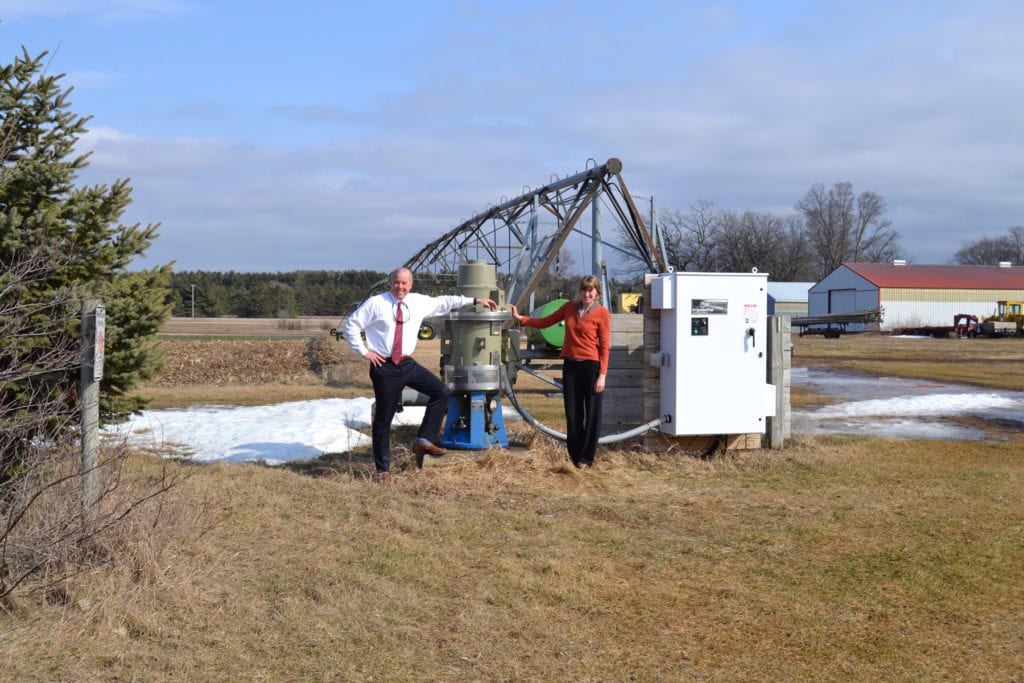
The single, most important issue facing the Wisconsin Potato & Vegetable Growers Association (WPVGA) and its Grower and Associate members in 2016 concerns high capacity wells and the need for certainty in acquiring permits for new wells along with those for repair/reconstruction/replacement of existing DNR-approved wells.
Additionally, all of these high capacity well permits must be transferable during property sales, to preserve property values.
The past two legislative sessions failed to reach an agreement regarding this issue, stalling 170 permits that threaten to sideline thousands of acres of cropland that will not yield crops without irrigation.
Into this quagmire, enters Assembly Bill 874 (AB 874/SB239), the last good hope for a resolution to this situation.

AB 874/SB239, which passed the Assembly and is now in the Senate, clarifies the regulatory framework for approved existing high capacity wells and directs the DNR to conduct a study in problem areas.
The Wisconsin Senate reconvened on March 15 to pass/deny remaining bills, including AB 874/SB239 before they adjourn for the remainder of the session until December 2016.
The Wisconsin Senate passed the bill but since they amended the bill by deleting section 5, the bill must return to the Wisconsin Assembly for vote on passage/deny. Unfortunately, the Wisconsin Assembly has already adjourned until December 2015 so it is highly unlikely that any action will occur before that date, so any current or additional pending high capacity well permits will remain in limbo.

However, Wisconsin’s growers cannot wait for the slow wheels of the legislative machine and WPVGA decided to search for their own solution on how to resolve the backlog of frozen permits.
After reviewing several consulting firms, WPVGA reached out to James Drought, P.H., Vice President and Principal Hydrogeologist for GZA GeoEnvironmental, Inc./Global Water Center to serve as their ‘point person’ coordinating the following efforts over the last year:
• Legislative support of the high capacity well bills
• Evaluation and development of alternative metrics for stream impairment
• Participating and reviewing the Little Plover River Model and Report
• Groundwater modeling in support of new and replacement high capacity wells

GZA’S CREDENTIALS
Founded in 1964, GZA employs more than 560 environmental, chemical, civil, and geotechnical engineers, scientists and technical support staff in 27 offices throughout the U.S.

This full-service company with highly diversified technical services supporting their core practice areas, is currently
is consistently ranked among the top 100 firms on Engineering News Record’s (ENR) annual list of the top 200 Environmental firms – ranking 89th in 2015 as well as among the top 500 ENR Design firms; ranking 126th in 2015.
GZA has a wealth of experience in water issues, engineering and regulatory permitting and offers tremendous depth and perspective in the development, management and protection of groundwater supplies and environmental conditions throughout southeastern Wisconsin, the Midwest and many areas of the United States.
A leader in groundwater services ranging from assessment of source and quality, and remediation alternatives, GZA has gained the respect of the regulatory community for the impartial and high-quality services provided by their firm.

DROUGHT’S QUALIFICATIONS
Drought has over 25 years of professional consulting experience in the development, protection/management of groundwater supplies, groundwater soil and groundwater remediation and litigation support services.
Drought received a Master of Science Degree in Contaminant Hydrogeology from UW-Milwaukee, and a Bachelor of Science Degree in Physical Geography and Biology from Carroll College, Waukesha, WI.
Drought also serves as an Associate Faculty Member, Environmental & Civil Engineering Department, Milwaukee School of Engineering, Milwaukee, WI.

He is also a member of National Ground Water Association, Wisconsin Ground Water Association and Federation of Environmental Technologists.
Drought has kindly agreed to be the focus of our feature interview this issue in order to bring our readership up to speed on the status of the GZA’s work over the last year and new developments and activities for 2016.
How did you and GZA GeoEnvironmental, Inc. become involved with WPVGA?
From the very beginning, we were very impressed with the relationships already developed between the WPVGA and governmental bodies as well as the significant financial contributions WPVGA has made annually to the University system on behalf of its grower members.
In March 2015, GZA was invited to present a strategy to represent WPVGA interests at a WPVGA Water Task Force involving the following core services:

• Hydrogeologic support and validation of the MODFLOW groundwater modeling by the Wisconsin Geologic and Natural History Survey (WGNHS) of the Little Plover River Watershed
• Environmental advocacy of the WPVGA with local, state and federal units and agencies of government
Subsequently, WPVGA carefully evaluated GZA’s credentials and understanding of their growers’ crop-specific needs and challenges and then selected GZA to utilize their professional skills and services to provide the following value and certainty to WPVGA:
• Understanding of and alternatives to reduce the cumulative impacts of pumping on drawdown, nearby wells and connected surface water features
• Facilitating the permitting and optimization of high capacity wells
• Development of water stewardship practices and sustainable irrigation methods
• Evaluation of the potential application of groundwater management districts for the management of surface water and groundwater
• Technical advocacy and representation of growers’ interest on groundwater resources, environmental compliance, permitting and regulation.

GZA is highly regarded for the respect it has earned from Wisconsin Department of Natural Resources (WDNR) and other governmental entities. Please explain the company’s philosophy of maintaining professional integrity while still representing the interests of your clients.
As an active participant in the rule-making and advisory committees that drive the water and water-regulated industries, GZA as gained the respect of the regulatory community for the impartial and high-quality services it provides.
By using valid and excellent science and empirical data, we represent the best interests of our clients at the local, state and federal levels.

Please share with us a brief explanation/synopsis on GZA’s qualifications for influencing legislative support of high capacity well legislation and list the principal members of your team assisting you with the GZA/WPVGA projects?
Founded in 1964, GZA has a wealth of experience in groundwater and environmental conditions throughout southeastern Wisconsin, the Midwest and many areas of the United States.
With over 500 professionals engaged in water issues, engineering and regulatory permitting, GZA offers tremendous depth and perspective in the development, management and protection of groundwater supplies.
GZA is a leader in groundwater services ranging from assessment of source and quality and remediation alternatives.
Besides me, GZA team members that regularly support our WPVGA projects include John Osborne, P.G., Jim Cai, P.E, Martin Hamper, P.G., Elizabeth Stapleton, Susan Karls, Janee Pederson, EIT and Anne Grzywa.

All of these team members have earned advanced academic degrees in water resources and hydrogeology and have contributed to the advancement of the mission and vision of the WPVGA.
Please share with us a brief explanation/synopsis of why there is a need for high capacity well legislation, a brief history of Wisconsin’s high capacity well legislation and GZA’s involvement in assisting WPVGA in influencing the 2015 legislative support and throughout 2016.
Groundwater is an important source of water for many human needs, including public water supply, agriculture and industry.
One of the primary concerns related to the development of groundwater resources in Wisconsin is the effect of pumping on streamflow and lake levels in seepage lakes.
Groundwater pumping can reduce the amount of groundwater that flows to streams and lakes and, in some cases, can draw streamflow into the underlying groundwater system.
Below is an outline of the evolution of high capacity well legislation in Wisconsin and the main elements of each phase.
PRE 2003 LEGISLATION
• Well construction standards
• Impacts to municipal wells
2003 WISCONSIN ACT 310 (GPA)
• Within 1,200 feet of trout stream or exceptional resource
• Impacts to Stream >1 cfs
• Water loss>95 percent (<5 percent return to basin)
LAKE BEULAH DECISION (July 6, 2011)
• Potential harm to Waters of State (broadly defined Chapter 281, Stats)
• Concrete, scientific evidence of potential harm
RICHFIELD DAIRY ADMINISTRATIVE LAW JUDGE’S OPINION (September 3, 2014)
• Consideration of cumulative Impacts
• Failure to consider represents a gap in the Public Trust Doctrine
The Richfield Dairy decision in 2014 requires WDNR to consider cumulative impacts for the siting of any new high capacity well.
GZA has supported WPVGA with the drafting of new legislation, defining the parameters for consideration of Sensitive Resource Areas (SRA) and, importantly, evaluating alternate metrics for stream impairment from potential depletions of high capacity wells.

This year, you completed a peer review of Ken Bradbury’s Little Plover River Model and Report. What were your final analysis and/or areas of concern regarding that model and report?
WPVGA has participated and provided support for the modeling activities conducted by WGNHS and provided water-gauging information from member wells.
On behalf of WPVGA, GZA completed an independent evaluation the inputs and outputs of the model and will be sharing our comments with WGNHS soon.
We have suggested a few refinements to the model to allow us to evaluate alternative mitigation scenarios for improving base flow to the Little Plover River in addition to those completed in 2015 as presented.

GZA GUIDE TO INTERPRETING THE LPR SIMULATION SCENARIO CHART RESULTS
1. These simulations were suggested by representatives of the WPVGA at a meeting on July 22, 2015.
2. Steady-state runs assume that the model parameters are fixed in time. Results of these runs are single values, representing average values for the year. Transient runs simulate changes through time. Results of transient runs vary throughout the model year. Therefore, for understanding the effects of transient simulations it is best to look at hydrographs (plots of streamflow through time) rather than single values.
3. The model is better suited for predicting changes in water levels and stream flow than for predicting absolute values. For this reason, it is best to look at the “change from base run” results when comparing scenarios. Although we have chosen specific model years for these simulations the specific year selected probably has little influence on the comparative results.
4. Streamflow results are presented in cubic feet per second, abbreviated CFS.
5. Streamflow results are referred to stream gage sites at Kennedy Avenue (Kennedy), Eisenhower Avenue (Eisenhower) and Hoover Avenue (Hoover).
6. We present single values of the public rights minimum flow.
7. We emphasize that these scenarios are for discussion only and do not represent actual planned activities.
Going forward, evaluation and development of alternative metrics for stream impairment are an important factor in garnering public support for agricultural environmental efforts. Please detail your progress with this critical aspect of the WPVGA goals.
Streamflow reductions caused by pumping have become an important water-resource management issue with the WDNR because of the potential effects that reduced flows can have on aquatic ecosystems, availability of surface waters and the quality and aesthetic value of streams and rivers.
Tamas Houlihan, Andy Wallendal, A.J. Bussan, Nick Somers and Andy Diercks have made significant investments and contributions to the discussion of alternative impairment metrics with the WDNR.
As shown on the attached Table 1 and Figure 1, our team demonstrated to the WDNR that by using multiple lines of evidence, the proposed stream impairment factor in the siting of new wells was overly conservative, and alternative factors should be considered.
We continue to work with the WDNR in the evaluation and development of these impairment criteria in comparison to the public right standards.
Additionally, please describe new groundwater modeling you are developing to help justify the building of new high capacity wells and replacement/repair of existing ones.
Scientific research has made important contributions to the basic understanding of the processes and factors that may affect streamflow and lake stages by wells.
Most groundwater flow models operate under steady-state conditions where model parameters and outputs such as pumping rates, groundwater recharge, stream base flows and groundwater levels remain constant with time.
However, the problems that groundwater flow models investigate are inherently transient. Many environmental variables are constantly changing over a variety of time scales ranging from very short (rainfall events, daily irrigation, etc.) to very long (seasonality, climate change, etc.).
We employ the most advanced methods for simulating groundwater systems with computer models provide powerful tools for estimating the rates, locations and timing of streamflow depletions in response to groundwater pumping and for evaluating alternative approaches for managing streamflow and lake levels.

Recently, you were hired by grower Ed Burns to create the ‘Buena Vista model’, which will help provide the necessary supportive data to determine cumulative impacts of existing wells in the region and help convince the DNR to grant an application for a new high capacity well on the Burns farm. Please explain this project and your progress thus far.
James Burns & Sons, Inc. applied to install a high capacity irrigation well in Portage County, WI, which is to be located near the headwaters of Buena Vista Creek.
Due to the complex nature of agriculture pumping in the Central Sand Region, the application status was on hold by the WDNR until GZA was retained to perform a groundwater modeling evaluation for use in the support of the application.
GZA has developed a conceptual Site model of the surface water and groundwater system near the Site.
A preliminary groundwater model domain for the nearfield, focusing on the Site vicinity and those streams/rivers potentially impacted by the proposed well, has been determined.
We completed model calibration and the local model will now be used to evaluate the pumping impact of the new well on groundwater level and surface water.
We have actively worked with the WDNR during all phases of model development.

If you are successful in using the Buena Vista Model to help Ed Burns obtain the permits he needs for his new high capacity well, how can you parlay that success into helping other growers who are facing similar scenarios.
The model domain for the Buena Vista Basin is broad and may be used by other Growers for both new and replacement wells.
We may also be asked to consider model development for the other areas of the state where the WDNR may be challenged in the review of new well applications due the complex nature of agriculture pumping and limited availability of stream and well data.
The general distribution of high capacity wells in Wisconsin is shown on Figure 2.

What advice do you suggest to growers during this time when no permits are being issued by WDNR if they find themselves need a new well or repair/reconstruction of an old one?
As we discussed at the WPVGA convention in February, several models exist for the Central Sands region that can be used to support WDNR applications for new and replacement wells.
Each of the models has unique strengths and limitations and GZA is available to WPVGA members to evaluate the potential application to specific locations.
View Badger Common’Tater Article (PDF)



